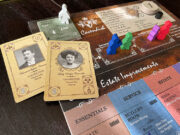 In the world of Dragonbond, dragons rule. Or is it the armies? We must hash this out in an epic battle for the ages. Could a dragon and an army general ever find peace amidst their differences and rule together? What a twist!
In the world of Dragonbond, dragons rule. Or is it the armies? We must hash this out in an epic battle for the ages. Could a dragon and an army general ever find peace amidst their differences and rule together? What a twist!
Dragonbond is an area control/troops on a map game for 1-4 players. The main game mode plays 4 players, but NPC factions can join for lower player counts. A typical game takes about 90 minutes.
Gameplay Overview:
In Dragonbond, players are taking on the role of either a general or a dragon, competing to gain the most power points. Players will start the game with their player board, hand of action cards, and deck of Vaala cards. The gameplay is broken up into 3 phases. During the planning phase, players program action or region cards in turn order, building the action stack that was started with an event card. Once a player passes on playing a card, they take the first-player token (unless they already have it). At that point, one more event card is added to the stack.

During the resolution phase, cards are resolved in the order they were played, starting with the first event card and ending with the second event card. Event cards often add power tokens or neutral units to the board. They can also give players additional actions or even force a dragon bond if conditions are in place. Glyphs on the action cards played provide a variety of actions to players. These include moving, initiating combat, collecting power, drawing/playing Vaala cards, and deploying units (generals only). Region cards allow three actions in order, but only for the player who currently controls the region depicted on the card played. These actions include upgrading units (via the denizen card market), reinforcing with more units, and placing a city token on the board.
Finally, during the clean-up phase, action cards are returned to the players’ hands, and region cards are claimed by the generals who control those regions. The denizen market is cleared and refilled from a freshly shuffled deck. Play continues on to the next planning phase. The game ends when a player reaches 10 power tokens, when the event deck runs out, or when a player is eliminated. In any case, the remaining player with the most power tokens wins the game.

Game Experience:
Dragonbond gets players into the action pretty quickly. The map is small enough that you are never more than a couple of moves away from another player. Conflict is further encouraged through power tokens and neutral units seeded around the board. This adds a good bit of dynamism to the game. However, sometimes the power tokens fall into one player’s lap, which can be frustrating.

Players are incentivized to control areas for power tokens as well as region cards, which provide players with special abilities. This was pleasantly reminiscent of the region card system in Inis. In terms of battles, we are talking dice-based combat, which I’m generally a fan of to begin with. Here, the attacking player starts by rolling a number of dice based on their combat value. Any critical hits are resolved immediately and wounds are dealt to the defender. At that point, the defender has the option to retreat or counterattack. If they counterattack, they must also resolve the attacker’s standard hits. This goes back and forth until one side retreats or there are no enemies left to fight. This push-your-luck aspect leads to fun battles. Additionally, there is an added thematic element where units (but not dragons) that cross a mountain into combat are at a disadvantage. Their first hit will be ignored. I love little details like that.
The action-planning phase had a lot of promise, but never quite manifested in a super-interesting way. Since one player can pass and end the planning phase, there are some rounds where every player only plays one or two cards, which does not generate the fun swinginess that I want in an action-programming game. Moves felt predictable for the most part.
I quite liked the Vaala cards. These can only be played during the resolution phase and provide a wide range of actions. Some provide a chaotic kick to the game, such as shuffling the remaining action deck. Some make for powerful moves, moving additional units into a region. Others are comparatively mild. Regardless, players must spend power tokens to use them. Spent tokens still count as victory points but must be managed well since they are so limited in the game.

General players and dragon players feel like they are playing two different games at times. That can be a cool feature in some games, like Root. Here, I was itching for more cohesion throughout. In fact, when I played the dragon side, it did not feel nearly as interesting as playing as a general. General players manage three different troop types, spreading influence throughout the map and marching armies around. The dragon players just have one unit. Furthermore, there is an upgrade system in place for the non-dragon troops that gives the general players a unique feeling in each game. Finally, dragon players cannot gain region cards. All that being said, playing as the dragon player felt a bit more powerful given how easily they can get around the board, pick up power tokens, and take out armies.
At points throughout the game, a general and a dragon player can form a dragonbond, at which point they win or lose together. This felt like too good of a move to pass up on. Unlike the bonding in Ankh, dragonbonded players still play their own game, which is nice. They also unlock new powers. However, I never once felt there was a way for an unbonded player to defeat a bonded team, so in practice, this mechanic felt a bit forced.

Dragonbond doesn’t overstay its welcome. You can get in and out in about 90 minutes. There’s also not much room for AP. Turns are relatively short as each action only involves a move or two. Combat turns take slightly longer, but even those are pretty quick.
Possibly my least favorite aspect of the game is its lack of scalability. The game felt like it was designed for four players only, but provides what seems to be a hastily whipped together way to play with fewer players. You can use AI players to fill in gaps, which just means random programming of actions for those factions. It’s pretty difficult and much less fun to try to strategize around a wildcard or two in the game. I did not enjoy playing this with two players. It felt like much less of a game.
Final Thoughts:
Maybe Dragonbond’s biggest sin is entering the crowded field of dudes on a map games without bringing much new. The relatively generic fantasy setting doesn’t hold much appeal to me nor does the theme come through very strongly. While the game’s appearance and the production values had me excited about this one, ultimately I came back to each successive play with less and less enthusiasm. The restrictive player count added some further difficulty for repeat plays. While I’d love to see what the expansion factions do for the game, I’m not anxious to go out of my way to find out.
Final Score: 3 Stars – an action-programming area-control game that doesn’t quite live up to its enticing premise
 Hits:
Hits:
• Clean and thematic battle system
• Vaala cards add a boost of chaos and room for power moves
• Beautiful aesthetics and nice production values
Misses:
• Does not scale well for less than 4 players
• Asymmetry is awkward and unbalanced
• Action programming never felt truly as exciting as it should
• Event cards add too much randomness





















